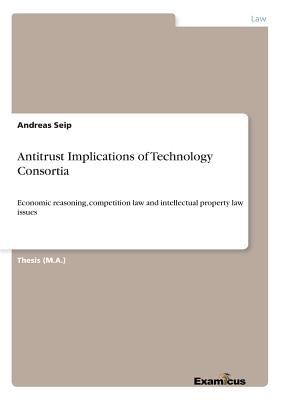
- We will send in 10–14 business days.
- Author: Andreas Seip
- Publisher: Examicus Verlag
- Year: 2012
- ISBN-10: 386943046X
- ISBN-13: 9783869430461
- Format: 14.8 x 21 x 0.7 cm, minkšti viršeliai
- Language: English
- SAVE -10% with code: EXTRA
Reviews
Description
Thesis (M.A.) from the year 2003 in the subject Law - Miscellaneous, grade: 1, University of Bonn, language: English, abstract: This thesis is to provide guidance for the antitrust analysis of technology consortia which is challenged by virtue of the various forms the inter-firm collaboration may take, the pooling of intellectual property rights (IPR) and the ambivalent impact this may have on competition. The starting point to a meaningful antitrust analysis of technology consortia is an understanding of the underlying economics. The following chapter is to briefly discuss the incentives of firms to cooperate, the contrasting stability issues prevailing in an anti-competitive cartel as opposed to innovation driven consortia, and the resultant welfare implications in terms of the benefits and risks of cooperation. This will allow an outline of the workable policy approach to be pursued in applying antitrust law. The third chapter focuses thereby on issues of antitrust analysis by distinguishing between two main types of technology consortia and their role in the innovation process. The assessment is to help the identification of the essential elements in antirust analysis ranging from relevant market definition to market power and intellectual property rights (IPR). In the fourth chapter, EC competition law is specifically examined against the discussed policy approach. This includes a consideration of relevant anti-competitive conduct relating to technology consortia under Article 81, the relevance of block exemptions, and finally the self-assessment under Article 81(3). In addition to a discussion of the intersection between IPR and Article 81, this will continue to be relevant for the assessment of IPR under Article 82. This chapter will end with a recommendation as to how IPR policies of technology consortia should be formulated to alleviate some antitrust concerns. The final chapter is to conclude that both intellectual property law and competition
EXTRA 10 % discount with code: EXTRA
The promotion ends in 23d.23:15:46
The discount code is valid when purchasing from 10 €. Discounts do not stack.
- Author: Andreas Seip
- Publisher: Examicus Verlag
- Year: 2012
- ISBN-10: 386943046X
- ISBN-13: 9783869430461
- Format: 14.8 x 21 x 0.7 cm, minkšti viršeliai
- Language: English English
Thesis (M.A.) from the year 2003 in the subject Law - Miscellaneous, grade: 1, University of Bonn, language: English, abstract: This thesis is to provide guidance for the antitrust analysis of technology consortia which is challenged by virtue of the various forms the inter-firm collaboration may take, the pooling of intellectual property rights (IPR) and the ambivalent impact this may have on competition. The starting point to a meaningful antitrust analysis of technology consortia is an understanding of the underlying economics. The following chapter is to briefly discuss the incentives of firms to cooperate, the contrasting stability issues prevailing in an anti-competitive cartel as opposed to innovation driven consortia, and the resultant welfare implications in terms of the benefits and risks of cooperation. This will allow an outline of the workable policy approach to be pursued in applying antitrust law. The third chapter focuses thereby on issues of antitrust analysis by distinguishing between two main types of technology consortia and their role in the innovation process. The assessment is to help the identification of the essential elements in antirust analysis ranging from relevant market definition to market power and intellectual property rights (IPR). In the fourth chapter, EC competition law is specifically examined against the discussed policy approach. This includes a consideration of relevant anti-competitive conduct relating to technology consortia under Article 81, the relevance of block exemptions, and finally the self-assessment under Article 81(3). In addition to a discussion of the intersection between IPR and Article 81, this will continue to be relevant for the assessment of IPR under Article 82. This chapter will end with a recommendation as to how IPR policies of technology consortia should be formulated to alleviate some antitrust concerns. The final chapter is to conclude that both intellectual property law and competition


Reviews